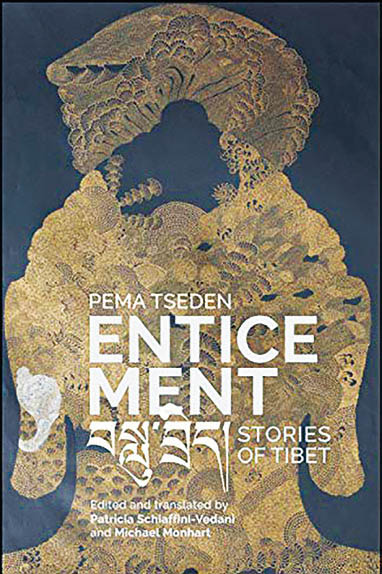Enticement: Stories of Tibet
Pema Tseden. 2018.
Enticement: Stories of Tibet, ed. and trans. by Patricia Schiaffini-Vedani and Michael Monhart
Albany, NY: State University of New York Press
ISBN 9781438474267
Enticement is a new window into contemporary literature about Tibet created by a Tibetan author and made accessible for all by its translators in English. Originality of the stories’ plots, which to some extent could even be called exotic, runs hand in hand with descriptions of universally shared feelings and challenges experienced by many people in their everyday life. Being a graphic piece of art, the book pictures a beautiful faraway world of Tibetan grassland, snowy mountains, and local people. Witty, naive, cunning, loving, joking, or distressed and going through hardship Tibetan characters frequently remind a reader of something personal and forgotten. The stories could refresh a memory from one’s childhood, something once felt or seen somewhere else. However, at the same time, a peculiar twist or twists of each story returns the reader back to the realities of Tibet.
As Pema Tseden puts it in the Author’s Preface: “Many times I write fiction for no other reason than to enter this state in which I can see and know myself more deeply. … All the words you want to say can be found in the texts you write” (p.1). Enticement, indeed, does not show modern Tibet as a flat postcard. Tseden’s words written down as stories set a reader on a trip of deeper contemplation – deeper into the wondering minds of Tibetans and deeper into one’s own inner world. Enticement as a compilation of ten stories touches upon completely different aspects of life: friendship, love and care, birth and death, treachery, loyalty, cruelty, modernization and globalization, Buddhist beliefs and local superstitions, extraordinary coincidences, and human reflections about life. While many stories tend to present rather realistic descriptions, in terms of literary styles one could encounter elements of traditional Tibetan folk tales (e.g. the traditional frame of the Golden Corpse Tales), examples of magical realism, or even science fiction.

Interwoven with Buddhist themes and traditional Tibetan cultural markers, Enticement goes further beyond the commonly understood topics of human happiness or grief. Tseden introduces a reader to the way of life on the Tibetan Plateau that is gradually going through changes. Alongside the main line of the plot, the author offers a glimpse of modern Tibet and the ongoing social transformations there: be it the existing tradition of religious reincarnations facing the modernity, Mao Zedong’s literary heritage still vividly living in the memory of Tibetan people, first encounters of Tibetans with a modern flow of Westerners enchanted with Tibetan culture, rural Tibetans not being able to speak Chinese or lacking the practical grasp of the urban Tibetan population and being beguiled by them, Tibetans being swept over by the wave of modernization in the form of compulsory ID registration, or struggling with the gambling plague.
The reader is travelling through Tibetan villages, cities and pastures. One gets to meet the curious minds seeking to see a bigger picture behind the average routine life, one gets to laugh at the funny perplexities of life, one gets to share the joy and pain of the protagonists, one gets to peek into modern Tibet and the various happenings there. Besides, there is no politics or anything didactical. These stories describe things simply as they are, void of any moralization. Enticement is Tibetan and universal at the same time. Despite the fact that the protagonists are Tibetan and are living in the conditions quite often unfamiliar for the bulk of us, a reader still can relate to their feelings. Most stories finely catch your attention and keep in suspense till the end.
I can assume that the perception of Tseden’s stories might vary for a reader with a different cultural background. However, being limited as a Western urban dweller and a Tibetan Studies student, I believe that Enticement is an exciting ride in the world with Tibetan flavour worth taking by anyone – be it a keen Tibetologist or any other interested reader. I would highly recommend reading this book to any reader willing to learn more of modern Tibet and would certainly suggest adding this book to a reading list for classes on modern Tibetan literature or culture.
Reviewed by: Natalia Moskaleva, Saint-Petersburg State University, Russia